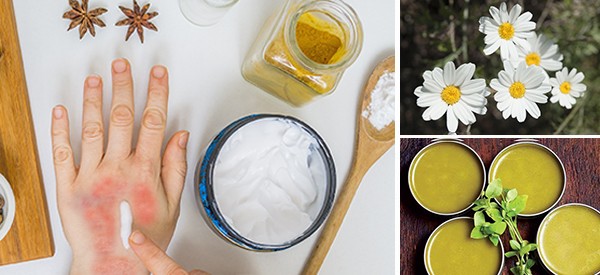
Backyard Plants You Can Use For Skin Rashes
Most of us have experienced a skin rash at some time. A rash could be due to exposure to a chemical substance, an insect bite, a plant such as poison ivy, a medical condition like lupus, an allergic reaction to something, or skin conditions such as eczema.
The rash and symptoms can be mild, but some are very itchy and/or painful. There are products you could buy, but natural, plant-based remedies are an attractive alternative for a variety of reasons.
While the list of plants that may help ease the symptoms of various types of rashes is a long one, we’ll focus on some that you can grow in your backyard, garden, or in a pot in your home.
CALENDULA (Calendula Officinalis)
Calendula has been shown to ease eczema and the inflammation associated with various rashes. The petals or flowers – either fresh or dried – are used as either an oil or a tea.
OIL: If you are unable to extract oil from the plant material yourself, you can purchase oil from a health shop. Making the oil, though, is not difficult:
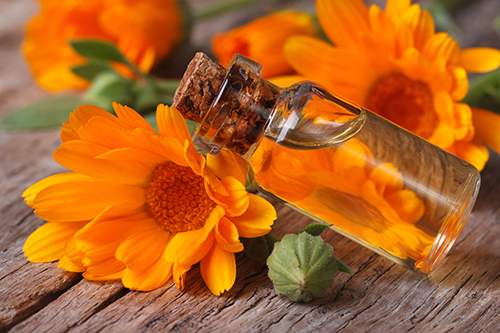
- Fill a glass jar 2/3 with dried flowers (either purchase dried flowers or dry fresh flowers for a minimum of 12 hours).
- Pour olive oil into the jar so that the flowers are covered and there is a further 1 inch / 2 ½ centimeters of oil above the flowers.
- Stir the mixture well and cover the jar with a tight cap or lid.
- Leave the jar in a sunny, warm spot for a period of 4 to 6 weeks and shake the jar daily.
- Strain the mixture and place the infused oil into a clean, labelled jar or bottle.
- Store the oil in a dark, cool place.
If the flowers were properly dried before being placed in the oil, this infusion will keep for 6 to 12 months. However, it will go rancid quickly if the flowers were not adequately dried.
The oil is usually applied to the skin twice daily. Alternatively, for more widespread rashes, the oil can be added to bathwater. You should soak in the bath for 10 to 15 minutes.
TEA: You can also use this plant to treat a rash by drinking Calendula tea or using the tea as a topical wash.
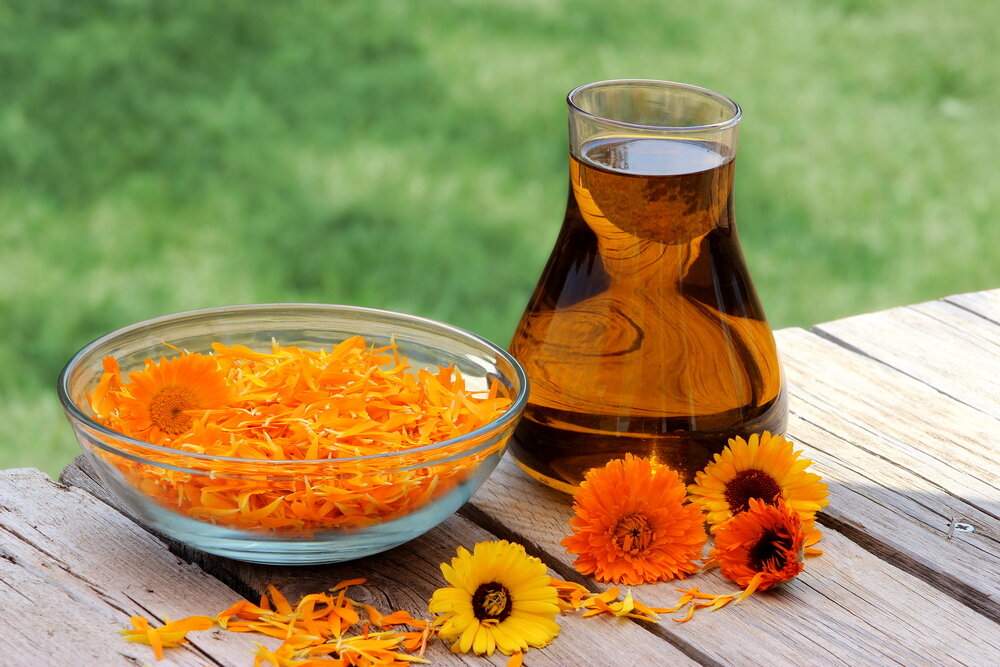
- Bring water to a simmer (not to a boil).
- Place 1 or 2 tablespoons dried flowers into a mug / cup. If the flowers are fresh, fill the cup.
- Pour the hot water over the flowers.
- Cover the cup or mug and leave the liquid to steep for 15 to 20 minutes or, with fresh flowers, until the tea is cool.
- Don’t add milk.
Store the tea in the fridge for a day or maximum two days. If you want to use the tea as an external wash, the tea must be stronger so use ¼ cup dried flowers topped up with hot water and allow to draw for an hour.
CHAMOMILE (Matricaria recutita or Chamaemelum nobile)
Both varieties of Chamomile work well, so you can use whichever is available to you. As with Calendula, you use the flowers. Chamomile is effective in easing the itching associated with many rashes thanks to its anti-inflammatory and anti-irritant properties. In addition, Chamomile has antibacterial and antifungal effects, so it helps with rashes with a variety of causes.
OIL: You can extract the oil yourself or you can purchase oil from a health shop. A word of caution, though: this oil is not cheap! To make infused oil:
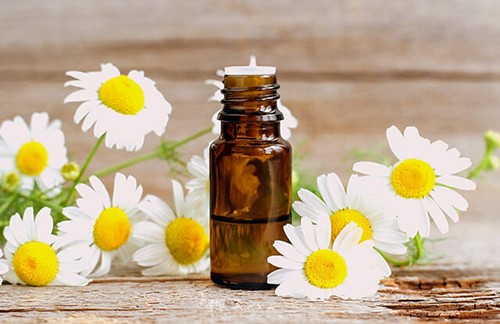
- Use dried flowers. If you have fresh flowers, dry them completely before you use them, or the oil will become moldy.
- Pour good quality olive oil into a glass jar. Leave ½ inch or just over 1 centimeter at the top.
- Add the dried flowers to the oil and mix well, making sure all the flowers are covered.
- Place a secure cap or cover on the jar and label it.
- Store the jar in an area where it will be in direct sunlight for 6 to 8 hours a day for 2 weeks.
- Open the jar daily and wipe any moisture from the underside of the lid. Close the jar again and shake it.
- Strain the oil into a clean jar, removing all the pieces of the flowers.
If the flowers were properly dried before being placed in the oil, this infusion will keep for 12 to 24 months. However, it will go rancid quickly if the flowers were not adequately dried. It can help to extend the life of the oil by adding a few drops of Rosemary oil extract. You will know the oil is ‘off’ if the smell and color change.
Many people add one or two drops of Chamomile oil to a moisturizer or body lotion. The oil is still effective when diluted and the bottle lasts longer. Alternatively, rub a small amount of the oil onto the affected area.
TEA and COMPRESS: You can also use this plant to treat a rash by the tea, using the tea in a compress, or as a topical wash.
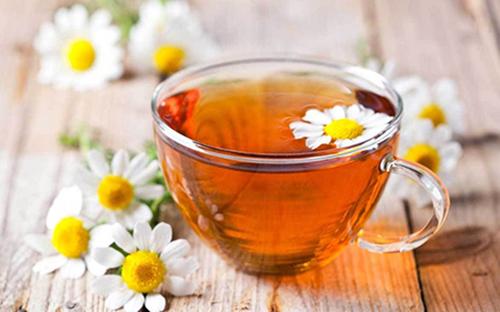
- Bring water to a simmer (not to a boil). If it boils, leave it cool a little before using it.
- Put 1 tablespoon of loose tea (or a bag) into a mug or cup. If you want to use a pot, use 1 tablespoon per cup.
- Pour the hot water over the tea and leave it to steep for 5 minutes or, if you prefer stronger tea, leave it longer.
- Use a strainer when you pour the tea into your cup or mug to remove the flower particles. A strainer is unnecessary if you used a bag.
- Don’t add milk but you can use honey or lemon if you prefer it that way.
You can also do a ‘cold brew’ using the same quantities of tea and water but using cold water and leaving it to steep for 12 to 24 hours in the fridge.
Chamomile tea can also be used in a compress. Soak a cloth in cool, strong (a heaped tablespoon in a cup of water) tea and then place the damp cloth over the affected area. Leave it in place for 10 minutes or 15 minutes if you need more relief. This can be done 2 or 3 times daily. If you prefer you can wash the area with the rash using cool or cold, strong tea and then gently dab the skin dry.
CHICKWEED (Stellaria media)
Chickweed is common and thought of more as a weed than a garden plant because of how fast it grows. However, it offers valuable anti-inflammatory properties which help ease the pain and / or itching of rashes. It is also an antiseptic and astringent, so it is soothing for the skin. The leaves are used to make infused oil, a salve, or you can buy Chickweed tea.
OIL: You can purchase oil from a health shop or make it yourself. If you opt for the DIY route, there are two methods you could use:
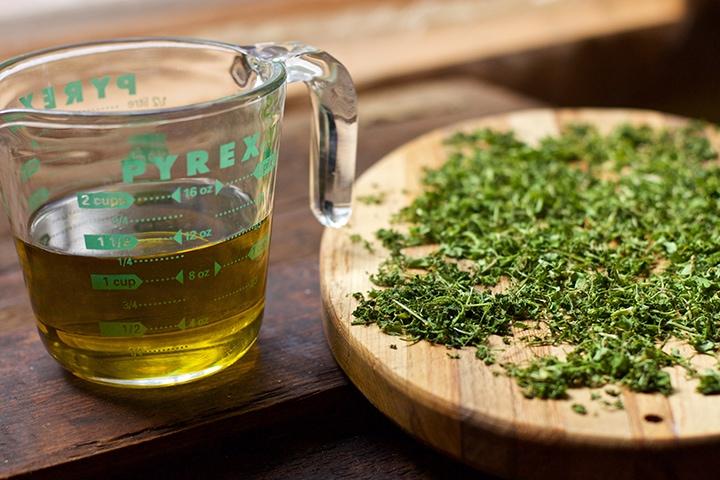
- Allow fresh Chickweed to wilt overnight so that it loses some moisture. You don’t have to do this, but oil is more likely to go rancid and won’t last as long if you don’t.
- Chop up the leaves, small stems, and flowers.
Hot method: Using heat significantly reduces the chance of mold in the oil
- Place the Chickweed into a slow-cooker or heavy-based pot so that the pot is almost full of plant material.
- Cover with pure olive or sunflower oil.
- Cook on high for 60 to 120 minutes then turn it to low. Check the pot often.
- The plant material will blacken. That’s normal; it’s not burnt.
Cold method:
- Fill a glass jar with Chickweed that has wilted and lost some of its moisture.
- Cover with pure olive or sunflower oil.
- Place a cap or lid on the jar and label it.
- Leave it to infuse for 14 to 28 days in a cool, dry place.
- Shake the jar daily and ensure that the Chickweed is covered with oil. A mature infusion will turn a deep green color.
- Strain the oil to remove all the plant matter.
- Apply the oil as is to the affected area or mix it with a lotion or cream.
It’s important to note that Chickweed oil is for external use only! If you have any adverse reaction to the oil, stop using it immediately. Oil that has not been mixed in with another preparation must be stored in the fridge. It has a shelf life of 12 to 18 months if correctly stored.
SALVE: As with the oil, you can either buy it from a supplier or make your own:

- Chop 2 large handfuls of fresh Chickweed that has wilted overnight.
- Mix the herb into 1 ¼ cups of pure olive oil.
- Simmer the mixture for 15 minutes and stir it every 5 or so minutes.
- Pour the oil into a heat-proof bowl and leave it in a cool, dark place and leave it to steep for 24 to 48 hours.
- Strain the oil so that all the plant material is removed.
- Stir the oil into 1 ounce / 28 grams of melted beeswax.
- Pour into a suitable container such as a small tin or jar with a lid and label it.
- Allow to cool and set.
The salve should be kept in a cool place so that it does not get too soft or melt. If made and stored correctly, the salve will have a shelf-life of 12 months.
While Chickweed oil and salve can be very soothing and ease several skin problems including rashes and itches, some people have an allergic reaction to this plant. Use a small amount first to ensure there isn’t a bade reaction. Also, don’t use it on open wounds or broken skin.
Calendula, Chamomile and Chickweed are all plants that can easily be grown in a garden or plant pot. Using them is also not difficult although you can purchase products too. While these teas, oils and salves offer great benefits for those suffering from rashes, they should be used with caution by some.
Those who should always check with a healthcare professional before using any plant preparation are pregnant and breastfeeding women, those with existing health conditions or those on prescribed medication.
Finally, if you are using one of these remedies but the rash is not improving or is getting worse, you are urged to seek the advice of a healthcare professional as some skin conditions can be serious or a symptom of an underlying medical condition.
You may also like:
If You See These White Spots on Your Plants, Don’t Touch Them
Similar to Morphine: The Best Natural Painkiller that Grows in Your Backyard (Video)
How To Safely Remove Poison Ivy And Hemlock From Your Backyard


I have not received the book yet. It was ordered abput 6 weeks ago. Help! Also I can’t access the online copy.
The online copy was on my initial email as a download. If you didn’t delete it…it should still be available for download
Hi Jean Paul,
Thank you so much for your comment.
Please accept our sincere apologies for the inconvenience.
Due to the global situation, we receive a high amount of e-mails and order requests.
We have sent you an e-mail and we are looking forward to your answer.
God bless!
I also have not received my copy ordered over 2 months ago. I expected some delay being from Canada but this is a bit much. Still hopeful.
Can you check the status of my order.
Hi Ruth,
Thank you so much for your comment.
Please accept our sincere apologies for this inconvenience.
Due to the global situation, we receive a high amount of e-mails and order requests.
We sent you an e-mail and we are looking forward to your answer.
God bless!
I ordered my copy s soon as it came out. It is worth waiting for.
Also, I bought an app to identify plants around my yard and it has been great with them both.
What is the name of the app to identify the plants around your yard? I am patiently waiting for my book.
I was also waiting for a physical book but in fact it was downloadable book that came in my inbox.
Hi Maribel,
Thank you for your interest in our work.
Please check your personal email. I sent you an email regarding your order.
Many blessings and good health!
[…] Backyard Plants You Can Use For Skin Rashes […]